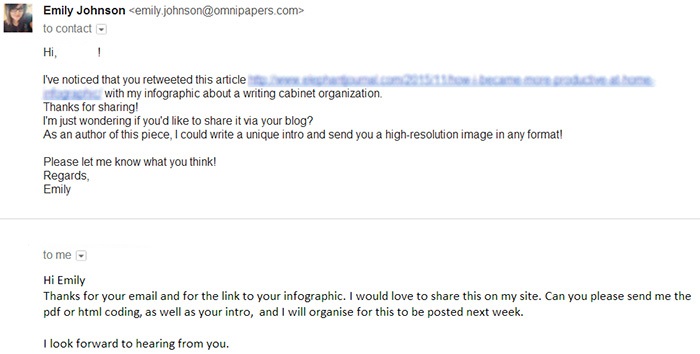ProBlogger: Tips on Building and Maintaining a Great Relationship with Readers | |
| Tips on Building and Maintaining a Great Relationship with Readers Posted: 29 Apr 2016 03:39 AM PDT
When it comes to blogging, nothing is more important than your readership – if you're publishing the best content in the world with no-one to read it, you quickly get into a Zen-style conundrum. If a tree falls in the forest and no-one is there to hear it, does its content reach the target audience? Building an honest, beneficial relationship with your readers is therefore one of the most important things you can do as a writer, and something that other blog writers often completely fail to do. Despite how uncommon it is, it's not as hard as they'd lead you to believe. First, you need to understand your audience.What do they need? What do they want from your blog? A good starting point is to say "my blog is for X kind of person who wants to do Y kind of thing”. For example, your blog could be for entrepreneurs who want to expand their customer base. From there, you know you can work towards supplying them with what they want. If you don't know enough about your readership to make those assumptions, change that as soon as possible! While programs like Google Analytics and Clicky can provide some insight into your readers, you'll get the best results by far from qualitative methods like surveys and polls. If you already have a few email list subscribers, now's the time to send them a survey or post up a poll. Your readers are the whole reason your blog exists, so get to know them! Related Reading: ProBlogger Podcast: Two Questions to Ask to Help You Find Readers for Your Blog Second, publish targeted, high-quality content.A relationship with your readers begins with you – and with your blog providing quality content. Simply put, you could be the most personable and charismatic writer imaginable, and it wouldn't do you any good if your content was poor. However, combining that charisma with high-quality, targeted content? That's the winning formula. Make sure to take care over your headlines, since they're the first thing the customer will see, and are valuable for SEO purposes – a good headline can really make or break your post. The headline is a promise that the content must then fulfil, and that is best done using a variety of content types to engage viewers and expand your audience beyond your core readers. Different content forms, if used correctly, can reach people far outside your normal catchment area, as some people who dislike reading blogs may happily listen to podcasts, and vice versa. This content should ideally be released as quickly as your audience can consume it – and as your popularity grows, so will the demand for your work. Encourage discussion in the comments – and respond to them.Asking your readers to contribute and share their thoughts in the comments can be a great way to build a relationship with them, as it turns your blog into more of a conversation, a forum where people are free to share their ideas and experiences and feel included. When someone comments on your post, make sure to thank them and respond to their questions or thoughts. Interact and engage them, and you suddenly the blog is a dialogue, and you are building a relationship with the readers through one-to-one interaction. If you need to stimulate your readers to comment, a simple call for participation or comments at the end of the post should do the job! When talking to your readers in the comments, make sure to stay positive, be as helpful as you can with any question or issue they have – and accept any criticism as gracefully as possible. Internet comments are notorious for their harsh and sometimes unjustified criticism, and writers need to develop a thick skin to deal with it. If you get confrontational or defensive, it can only end badly for you – it makes you look bad, stifles honest discussion, and prevents good relationship building between you and your readership. Build interactions and relationships on other channelsYour blog comments are not the only avenue of conversation with your readers – you can also discuss and interact with them through an email mailing list, on twitter, via a Facebook Page or Instagram account, or on forums like Reddit. Finding the communities that your audience haunts can be a great way to build up a level of familiarity and respect, and is an excellent way not only to maintain a good relationship with your readers, but to find other blogs similar to yours as well. Many of your readers will have blogs of their own, and where it is useful to your audience, it will be worth mentioning or linking to those blogs. Once you've found blogs that fit your niche, working with those authors to build your blogs together and connect across the board can often mean reaching an entirely new reader-base and will allow you the chance to build a relationship with some of your most active readers. Don't be afraid to jump in and become part of the community – at the end of the day, that's how really great relationships are made! Dan Goss is the editor and chief content writer for Customer Service Guru, a UK-based site working on improving customer relations, customer experience and business practices the world over. When he isn't writing, he can be found at your nearest coffee machine. The post Tips on Building and Maintaining a Great Relationship with Readers appeared first on ProBlogger. |
| You are subscribed to email updates from ProBlogger. To stop receiving these emails, you may unsubscribe now. | Email delivery powered by Google |
| Google Inc., 1600 Amphitheatre Parkway, Mountain View, CA 94043, United States | |



 This is a guest contribution from Dan Goss.
This is a guest contribution from Dan Goss.








